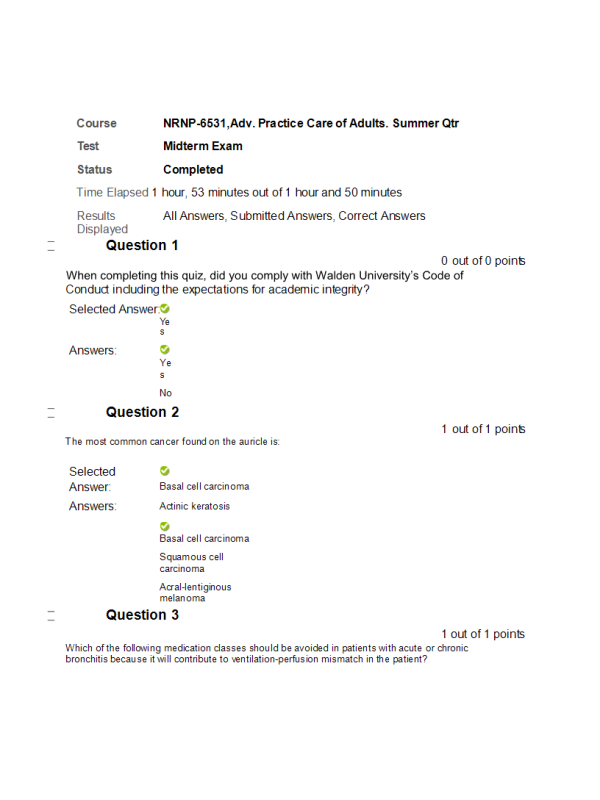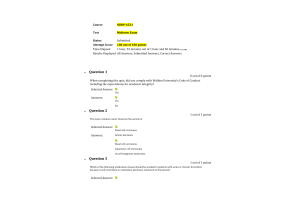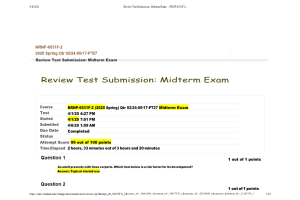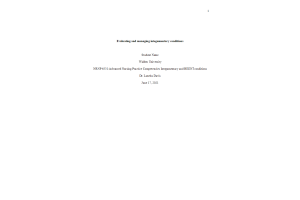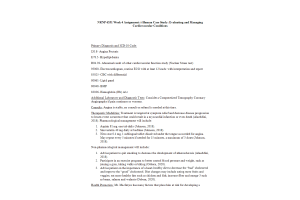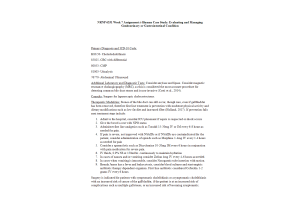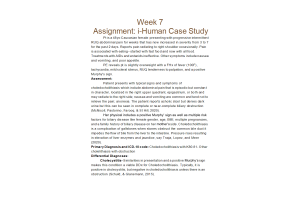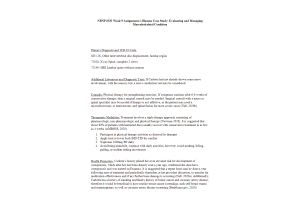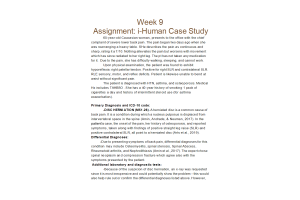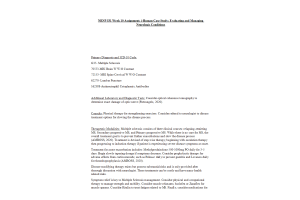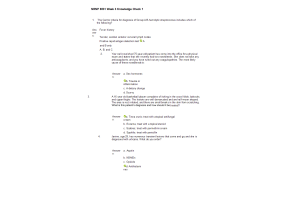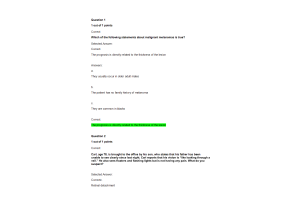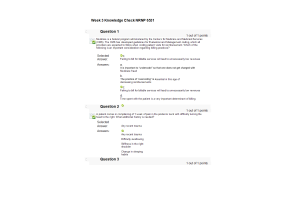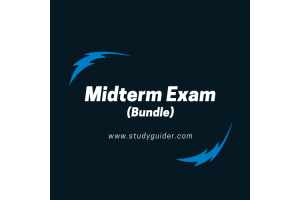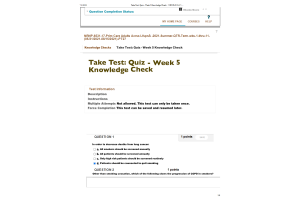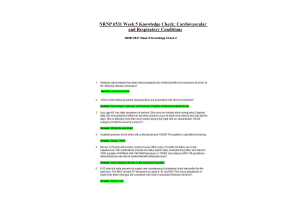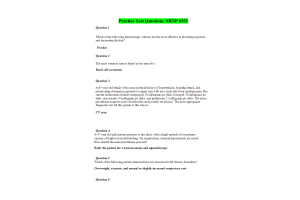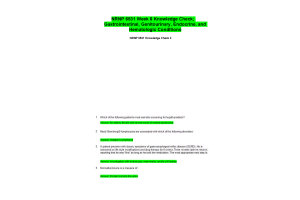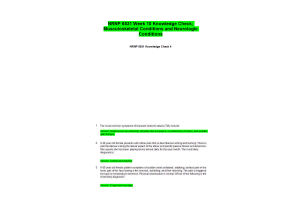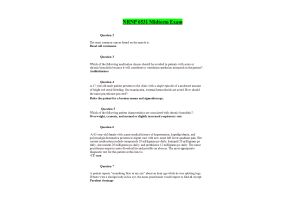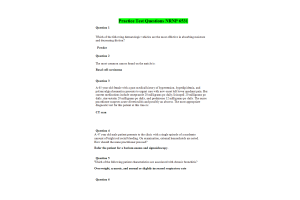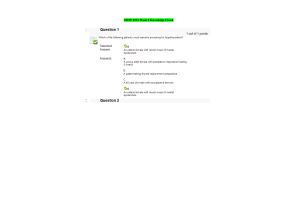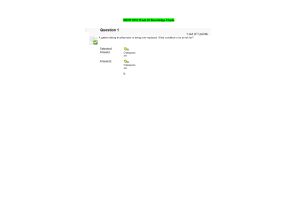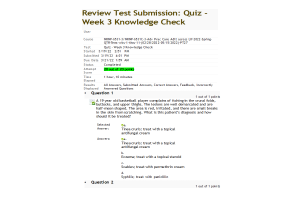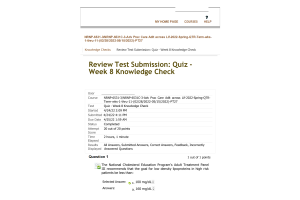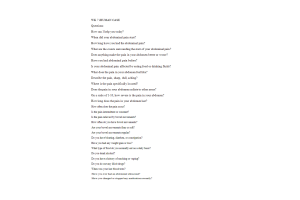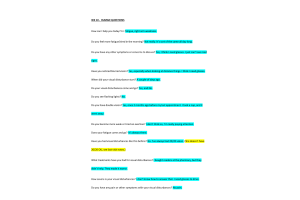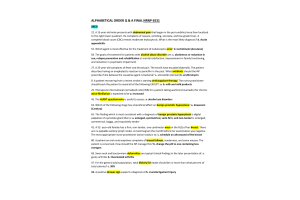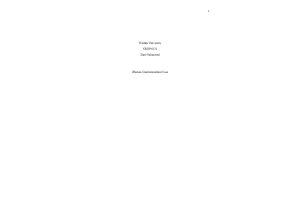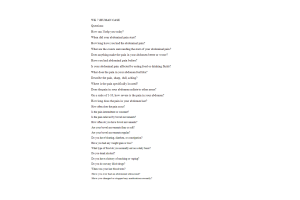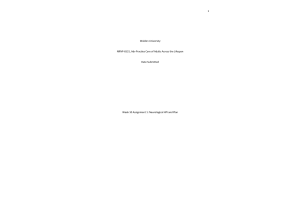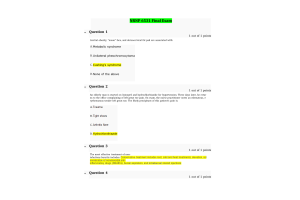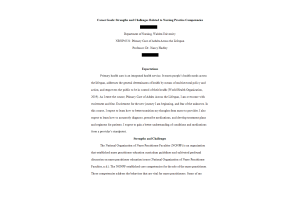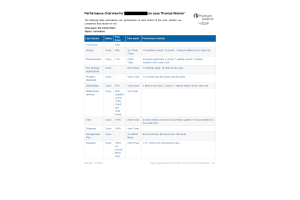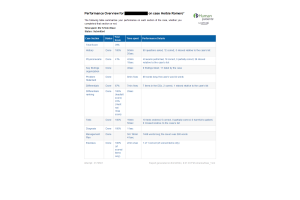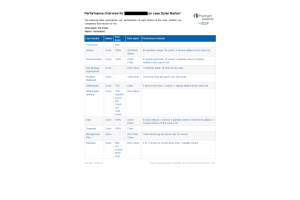NRNP 6531 Week 11 Final Exam Compliation
- $69.00
- Question: When completing this quiz, did you comply with Walden University’s Code of Conduct including the expectations for academic integrity?
- Question: The most common cancer found on the auricle is:
- Question: Which of the following medication classes should be avoided in patients with acute or chronic bronchitis because it will contribute to ventilation-perfusion mismatch in the patient?
- Question: A 47 year old male patient presents to the clinic with a single episode of a moderate amount of bright red rectal bleeding. On examination, external hemorrhoids are noted. How should the nurse practitioner proceed?
- Question: Which of the following patient characteristics are associated with chronic bronchitis?
- Question: A 65-year-old female with a past medical history of hypertension, hyper lipidemia, and polymyalgia rheumatica presents to urgent care with new onset left lower quadrant pain. Her current medications include omeprazole 20 milligrams po daily, lisinopril 20 milligrams po daily, simvastatin 20 milligrams po daily, and prednisone 12 milligrams po daily. The nurse practitioner suspects acute diverticulitis and possibly an abscess. The most appropriate diagnostic test for this patient at this time is:
- Question: A patient reports “something flew in my eye” about an hour ago while he was splitting logs. If there were a foreign body in his eye, the nurse practitioner would expect to find all except:
- Question: A 21 year old college student presents to the student health center with copious, markedly purulent discharge from her left eye. The nurse practitioner student should suspect:
- Question: A 35 year old man presents with radicular pain followed by the appearance of grouped vesicles consisting of about 15 lesions across 3 diferent thoracic dermatomes. He complains of pain, burning, and itching. The nurse practitioner should suspect:
- Question: Which type of lung cancer has the poorest prognosis?
- Question: An 83-year-old female presents to the office complaining of diarrhea for several days. She explains she has even had fecal incontinence one time. She describes loose stools 3– 4 times a day for several weeks and denies fever, chills, pain, recent antibiotic use. The history suggests that the patient has:
- Question: Margaret, age 32, comes into the office with painful joints and a distinctive rash in a butterfly distribution on her face. The rash has red papules and plaques with a fine scale. What do you suspect?
- Question: Antibiotic administration has been demonstrated to be of little benefit to the treatment of which of the following disease processes?
- Question: Lisa, age 49, has daily symptoms of asthma. She uses her inhaled short-acting beta-2 agonist daily. Her exacerbations afect her activities and they occur at least twice weekly and may last for days. She is afected more than once weekly during the night with an exacerbation. Which category of asthma severity is Lisa in?
- Question: Which of the following is the most appropriate therapeutic regimen for an adult patient with no known allergies diagnosed with group A B-hemolytic strep?
- Question: Acashiercomplainsofdullacheandpressuresensationinherlowerlegs.Itisrelievedby leg elevation. She occasionally has edema in her lower legs at the end of the day. What is the most likely cause of theseproblems?
- Question: Which statement below is correct about pertussis?
- Question: Which of the following is the most important diagnosis to rule out in the adult patient with acute bronchitis?
- Question: A 70 year old patient presents with left lower quadrant (LLQ) abdominal pain, a markedly tender palpable abdominal wall, fever, and leukocytosis. Of the following terms, which correctly describes the suspected condition?
- Question: Sylvia, age 83, presents with a 3 day history of pain and burning in the left forehead. This morning she noticed a rash with erythematous papules in that site. What do you suspect?
- Question: A 33-year-old female is admitted with acute pancreatitis. The nurse practitioner knows that the most common cause of pancreatitis is:
- Question: When a patient presents with symptoms of acute gallbladder disease, what is the appropriate nurse practitioner action?
- Question: A false-positive result with the fecal occult blood test can result from:
- Question: A 76-year-old male complains of weight loss, nausea, vomiting, abdominal cramping and pain. Physical findings include an abdominal mass and stool positive for occult blood. The nurse practitioner pain suspects a tumor in the small intestine. The best diagnostic test for this patient is:
- Question: A patient presents to urgent care complaining of dyspnea, fatigue, and lower extremity edema. The echocardiogram reveals and ejection fraction of 38%. The nurse practitioner knows that these findings are consistent with:
- Question: Maxine, Age 76, has just been given a diagnosis of pneumonia. Which of the following is an indication that she should be hospitalized?
- Question: A 55 year old man is diagnosed with basal cell carcinoma. The nurse practitioner correctly tells him:
- Question: Expected spirometry readings when the patient has chronic emphysema include:
- Question: An 80-year-old male admits to difficulty swallowing during the review of systems. The nurse practitioner recognizes the differential diagnosis for this patient’s dysphagia is:
- Question: A40yearoldfemalewithhistoryoffrequentsunexposurepresentswithamulticolored lesion on her back. It has irregular borders and is about 11mm in diameter. What should the nurse practitioner suspect?
- Question: Which of the following is not a goal of treatment for the patient with cystic fibrosis?
- Question: Thenursepractitionerisperformingaphysicalexamonamiddle-agedAfrican-American man. Which of the following areas is a common site for melanomas in African-Americans and other dark-skinned individuals?
- Question: An adult presents with tine a corporis. Which item below is a risk factor for its development?
- Question: A patient has experienced nausea and vomiting, headache, malaise, low grade fever, abdominal cramps, and watery diarrhea for 72 hours. His white count is elevated with a shift to the left. He is requesting medication for diarrhea. What is the most appropriate response?
- Question: Janine, age 29, has numerous transient lesions that come and go, and she is diagnosed with urticaria. What do you order?
- Question: Of the following signs and symptoms of congestive heart failure (CHF), the earliest clinical manifestation is:
- Question: A 16 year old male presents with mild sore throat, fever, fatigue, posterior cervical adenopathy, and palatine petechiae. Without a definitive diagnosis for this patient, what drug would be least appropriate to prescribe?
- Question: A 70 year old man who walks 2 miles every day complains of pain in his left calf when he is walking. The problem has gotten gradually worse and now he is unable to complete his 2 mile walk. What question asked during the history, if answered affirmatively, would
- Question: Which of the following statements about malignant melanomas is true?
- Question: Sheila, age 78, presents with a chief complaint of waking up during the night coughing. You examine her and find an S3 heart sound, pulmonary crackles that do not clear with coughing, and peripheral edema. What do you suspect?
- Question: Which antibiotic would be the most effective in treating community acquired pneumonia (CAP) in a young adult without any com or bid conditions?
- Question: Which of the following dermatologic vehicles are the most effective in absorbing moisture and decreasing friction?
- Question: 70 year old patient presents with a slightly raised, scaly, erythematous patch on her forehead. She admits to having been a “sun worshiper.” The nurse practitioner suspects actinic keratos is. This lesion is a precursor to:
- Question: An elderly patient is being seen in the clinic for complaint of “weak spells” relieved by sitting or lying down. How should the nurse practitioner proceed with the physical examination?
- Question: What oral medication might be used to treat chronic cholethias is in a patient who is a poor candidate for surgery?
- Question: A 46-year-old female with a past medical history of diabetes presents with a swollen, erythematous right auricle and is diagnosed with malignant otitis externa. The nurse practitioner knows that the most likely causative organism for this patient’s problem is:
- Question: Which of the following is not a symptom of irritable bowel syndrome?
- Question: A patient comes in complaining of 1 week of pain in the posterior neck with difficulty turning the head to the right. What additional history is needed?
- Question: Marvin, age 56, is a smoker with diabetes. He has just been diagnosed as hypertensive. Which of the following drugs has the potential to cause the development of bronchial asthma and inhibit gluconeogenesis?
- Question: The differential diagnosis for a patient complaining of a sore throat includes which of the following?
- Question: A patient presents to the primary care provider complaining of a rash on his right forehead that started yesterday and is burning and painful. The physical exam reveals an erythematous, maculopapular rash that extends over the patient’s right eye to his upper right forehead. Based on the history and examination, the most likely cause of this patient’s symptoms is:
- Question: Before initiating an HMG CoA-reductase inhibitor for hyper lipidemia, the nurse practitioner orders liver function studies. The patient’s aminotransferase (ALT) is elevated. What laboratory test(s) should be ordered?
- Question: A patient with elevated lipids has been started on lovastatin. After 3 weeks of therapy, he calls to report generalized muscle aches. The nurse practitioner should suspect:
- Question: Treatment of acute vertigo includes:
- Question: Treatment of H.pylori includes which of the following?
- Question: Carl, age 78, is brought to the office by his son, who states that his father has been unable to see clearly since last night. Carl reports that his vision is “like looking through a veil.” He also sees floaters and flashing lights but is not having any pain. What do you suspect?
- Question: In order to decrease deaths from lung cancer:
- Question: John, age 33, has a total cholesterol level of 188 mg/dL. How often should he be screened for hypercholesterolemia?
- Question: Mort is hypertensive. Which of the following factors influenced your choice of using an alpha blocker as the antihypertensive medication?
- Question: John, age 59, presents with recurrent, sharply circumscribed red papules and plaques with a powdery white scale on the extensor aspect of his elbows and knees. What do you suspect?
- Question: Harriet,a79-year-oldwoman,comestoyourofficeevery3monthsforfollowuponher hypertension. Her medications include one baby aspirin daily, Lisinopril 5mg daily, and Calcium 1500 mg daily. At today’s visit. Her blood pressure is 170/89. According to JNC VIII guidelines, what should you do next to control Harriet’s blood pressure?
- Question: An active 65-year-old man under your care has known acquired valvular aortic stenosis and mitral regurgitation. He also has a history of infectious endocarditis. He has recently been told he needs elective replacement of his aortic valve. When he comes into the office you discover that he has 10 remaining teeth in poor repair. Your recommendation would be to:
- Question: Appropriate therapy for peptic ulcer disease (PUD) is:
- Question: Shirley, age 58, has been a diabetic for 7 years. Her blood pressure is normal. Other than her diabetes medications, what would you prescribe today during her routine office visit?
- Question: Medicare is a federal program administered by the Centers for Medicare and Medicaid Services (CMS). The CMS has developed guidelines for Evaluation and Management coding, which all providers are expected to follow when coding patient visits for reimbursement. Which of the following is an important consideration regarding billing practices?
- Question: A 2 year old presents with a white pupillary reflex. What is the most likely cause of this finding?
- Question: Harvey has had Meniere’s disease for several years. He has some hearing loss but now has persistent vertigo. What treatment might be instituted to relieve the vertigo?
- Question: Whichofthefollowingisnotariskfactorforcoronaryarterialinsufficiency?
- Question: An 18-year-old female presents to the urgent care center complaining of severe pruritus in both eyes that started 2 days ago. Associated symptoms include a headache and fatigue. On examination, the nurse practitioner notes some clear discharge from both eyes and some erythema of the eyelids and surrounding skin. Which of the following is the most likely cause of this patient’s symptoms?
- Question: A 20 year old is diagnosed with mild persistent asthma. What drug combination would be most effective in keeping him symptom-free?
- Question: Acute rheumatic fever is an inflammatory disease which can follow infection with:
- Question: A 60 year old male diabetic patient presents with redness, tenderness, and edema of the left lateral aspect of his face. His left eyelid is grossly edematous. He reports history of a toothache in the past week which “is better.” His temperature is 100°F and pulse is 102 bpm. The most appropriate initial action is to:
- Question: If a patient presents with a deep aching, red eye and there is no discharge, you should suspect:
- Question: The National Cholesterol Education Program’s Adult Treatment Panel III recommends that the goal for low density lipoproteins in high risk patients be less than:
- Question: A patient presents with classic symptoms of gastro esophageal reflux disease (GERD). He is instructed on life style modifications and drug therapy for 8 weeks. Three months later he returns, reporting that he was “fine” as long as he took the medication. The most appropriate next step is:
- Question: Group A β-hemolytic streptococcal (GABHS) pharyngitis is most common in which age group?
- Question: The most appropriate treatment for a child with mild croup is:
- A child complains that his “throat hurts” with swallowing. His voice is very “throaty” tonsils. His uvula is deviated to the left. What is the most likely diagnosis
- Question: Salmeterol (Servent) is prescribed for a patient with asthma. What is the most important teaching point about this medication?
- Question: Which intervention listed below is safe for long term use by an adult with constipation?
- Question: A 40 year old presents with a hordeolum. The nurse practitioner teaches the patient to:
- Question: Sarah has allergic rhinitis and is currently being bothered by nasal congestion. Which of the following meds ordered for allergic rhinitis would be most appropriate?
- Question: What is the Gold standard for the diagnosis of asthma?
- Question: A patient complains of “an aggravating cough for the past 6 weeks.” There is no physiological cause for the cough. Which medication is most likely causing the cough?
- Question: Stacy, age 27, states that she has painless, white, slightly raised patches in her mouth. They are probably caused by:
- Question: Riskfactorsforacuteotitismedia(AOM)includeallofthefollowingexcept:
- Question: Which of the following can result from chronic inflammation of a meibomian gland?
- Question: What conditions must be met for you to bill “incident to” the physician, receiving 100% reimbursement from Medicare?
- Question: Of the following choices, the least likely cause of cough is:
- Question: The most common correlate(s) with chronic bronchitis and emphysema is(are):
- Question: Which choice below is least efective for alleviating symptoms of the common cold?
- Question: When teaching a patient with hypertension about restricting sodium, you would include which of the following instructions?
- Question: Which of the following heart murmurs warrants the greatest concern?
- Question: A patient presents with an inflamed upper eyelid margin. The conjunctiva is red and there is particulate matter along the upper eyelid. The patient complains of a sensation that “there is something in my eye.” What is the diagnosis and how should it be treated?
- Question: A 57-year-old male presents to urgent care complaining of substernal chest discomfort for the past hour. The EKG reveals ST elevations in Leads II, III, and AVF. The nurse practitioner is aware that these changes are consistent with which myocardial infarction territory?
- Question: The nurse practitioner observes a tympanic membrane that is opaque, has decreased mobility, and is without bulging or inflammation. The least likely diagnosis for this patient is:
- Question: Alan, age 54, notices a bulge in his midline every time he rises from bed in the morning. You tell him it is a ventral hernia, also known as:
- Question: A 58-year-old man is diagnosed with Barrett’s esophagus after an endoscopy. He has no known allergies. Which of the following medications is MOST appropriate to treat this patient’s disorder?
- Question: Larry, age 66, is a smoker with hyperlipidemia and hypertension. He is 6 months post-MI. To prevent reinfarction, the most important behavior change that he can make is to:
- Question: Risk factors for acute arterial insufficiency include which of the following?
- Question: Impetigo and folliculitis are usually successfully treated with:
Next Exam
- Question: What is the maximum compensation of PaCO2 in metabolic acidosis?
- Question: Which of the following is a potential acquired cause of thrombophilia
- Question: Phalen's test, 90°wrist flexion for 60 seconds, reproduces symptoms of:
- Question: Which patient would benefit most from screening for type 2 diabetes?
- Question: A 72 year old female patient reports a 6 month history of gradually progressive swollen and painful distal interphalangeal (DIP) joints of one hand. She has no systemic symptoms but the erythrocyte sedimentation rate (ESR), antinuclear antibody (ANA), and rheumatoid factor (RF) are all minimally elevated. What is the most likely diagnosis?
- Question: A 32 year old male patient complains of urinary frequency and burning on urination for 3 days. Urinalysis reveals bacteriuria. He denies any past history of urinary tract infection. The initial treatment should be:
- Question: A thymectomy is usually recommended in the early treatment of which disease?
- Question: The diagnosis of human papilloma virus (HPV) infection in males is usually made by
- Question: The most effective intervention(s) to prevent stroke is (are):
- Question: What is the most common cause of Cushing's syndrome?
- Question: Diagnostic radiological studies are indicated for low back pain:
- Question: After treating a patient for Helicobacter pylori infection, what test do you order to see if it has been cured?
- Question: Which appropriate test for the initial assessment of Alzheimer's disease provides the performance ratings on 10 complex, higher order activities?
- Question: Major depression occurs most often in which of the following conditions?
- Question: Which of the following statements about multiple sclerosis (MS) is correct?
- Question: Diagnostic evaluation of hypothyroidism reveals:
- Question: Risk factors for prostate cancer include all of the following except:
- Question: What information should patients with diabetes and their families receive about hypoglycemia?
- Question: Which history is commonly found in a patient with glomerulonephritis?
- Question: Which of the following is characteristic of a manic episode?
- Question: Central obesity, "moon" face, and dorsocervical fat pad are associated with:
- Question: Which of the following is the most common cause of low back pain?
- Question: A middle-aged female presents complaining of recent weight loss. The physical exam reveals an enlarged painless cervical lymph node. The differential diagnosis for this patient's problem includes:
- Question: An 81-year-old female is diagnosed with type 2 diabetes. When considering drug therapy for this patient, the nurse practitioner is most concerned with which of the following side effects?
- Question: A patient has HIV infection and is having a problem with massive diarrhea. You suspect the cause is
- Question: Which of the following is the most common causative organism of nongonococcal urethritis?
- Question: The most common symptoms of transient ischemic attack (TIA) include
- Question: What is the first symptom seen in the majority of patients with Parkinson's disease?
- Question: A 21-year-old female presents to the office complaining of urinary frequency and urinary burning. The nurse practitioner suspects a urinary tract infection when the urinalysis reveals
- Question: A 26 year old female presents with elbow pain that is described as aching and burning. There is point tenderness along the lateral aspect of the elbow and painful passive flexion and extension. She reports she has been playing tennis almost daily for the past month. The most likely diagnosis is:
- Question: Maria, age 17, was raped when she was 13 year old. She is now experiencing sleeping problems, flashbacks, and depression. What is your initial diagnosis?
- Question: An elderly man is started on lisinopril and hydrochlorhiazide for hypertension. Three days later, he returns to the office complaining of left great toe pain. On exam, the nurse practitioner notes an edematous, erythematous tender left great toe. The likely precipitant of this patient's pain is:
- Question: Which of the following is a contraindication for metformin therapy?
- Question: A positive drawer sign supports a diagnosis of:
- Question: Steve, age 69, has gastroesophageal reflux disease (GERD). When teaching him how to reduce his lower esophageal sphincter pressure, which substances do you recommend that he avoid?
- Question: A patient taking levothyroxine is being over-replaced. What condition is he at risk for?
- Question: Diabetes screening recommendations for asymptomatic adults age 45 and over include which of the following:
- Question: Dave, age 38, states that he thinks he has an ear infection because he just flew back from a business trip and feels unusual pressure in his ear. You diagnose barotrauma. What is your next action?
- Question: Josh, age 22, is a stock boy and has an acute episode of low back pain. You order and NSAID and tell him which of the following?
- Question: Risk factors for Addison's disease include which of the following?
- Question: Urine cultures should be obtained for which of the following patients?
- Question: Jennifer says that she has heard that caffeine can cause osteoporosis and asks you why. How do you respond?
- Question: The diagnosis which must be considered in a patient who presents with a severe headache of sudden onset, with neck stiffness and fever, is:
- Question: What conditions must be met for you to bill "incident to" the physician, receiving 100% reimbursement from Medicare?
- Question: The most commonly recommended method for prostate cancer screening in a 55 year old male is:
- Question: The primary goals of treatment for patients with alcohol abuse disorder are:
- Question: You are assessing a patient after a sports injury to his right knee. You elicit a positive anterior/posterior drawer sign. This test indicates an injury to the:
- Question: Marsha presents with symptoms resembling both fibromyalgia and chronic fatigue syndrome, which have many similarities. Which of the following is more characteristic of fibromyalgia?
- Question: Differential diagnosis of proteinuria includes which of the following?
- Question: A patient presenting for an annual physical exam has a BMI of 25 kg/m2 This patient would be classified as:
- Question: Reed-Sternberg B lymphocytes are associated with which of the following disorders:
- Question: A 77-year-old female presents to the office complaining a sudden swelling on her right elbow. She denies fever, chills, trauma, or pain. The physical exam reveals a non-tender area of swelling over the extensor surface over the right elbow with evidence of trauma or irritation. The nurse practitioner suspects:
- Question: A 77-year-old female presents to the office complaining a sudden swelling on her right elbow. She denies fever, chills, trauma, or pain. The physical exam reveals a non-tender area of swelling over the extensor surface over the right elbow with evidence of trauma or irritation. The nurse practitioner suspects:
- Question: Establishment of a definitive diagnosis of osteomyelitis requires:
- Question: The most accurate measure of diabetes control is:
- Question: A patient has been diagnosed with generalized anxiety disorder (GAD). Which of the following medications may be used to treat generalized anxiety disorder?
- Question: The most common presentation of thyroid cancer is:
- Question: Which of the following accounts for half of the bladder tumors among men and one-third in women?
- Question: You have a new patient that presents with generalized lymphadenopathy. You know that this is indicative of:
- Question: Sally, a computer programmer, has just been given a new diagnosis of carpal tunnel syndrome. Your next step is to:
- Question: Which drug category contains the drugs that are the first line Gold standard therapy for COPD?
- Question: Potential causes of septic arthritis include which of the following?
- Question: The nurse practitioner diagnoses epididymitis in a 24 year old sexually active male patient. The drug of choice for treatment of this patient is:
- Question: A patient has been taking fluoxetine (Prozac) since being diagnosed with major depression, first episode, 2 months ago. She reports considerable improvement in her symptoms and her intention to discontinue the medication. What should be the nurse practitioner's recommendation?
- Question: Your patient has an elevated mean cell volume (MCV). What should you be considering in terms of diagnosis?
- Question: Which of the following medications increase the risk for metabolic syndrome?
- Question: The hallmark of neurofibromatosis (von Recklinghausen's disease) present in almost 100% of patients is
- Question: The most commonly recommended pharmacological treatment regimen for low back pain (LBP) is:
- Question: Legal authority for advanced practice nursing rests with:
- Question: Which of the following physical modalities recommended for treatment of rheumatoid arthritis provides the most effective long term pain relief?
- Question: A patient presents with dehydration, hypotension, and fever. Laboratory testing reveals hyponatremia, hyperkalemia, and hypoglycemia. These imbalances are corrected, but the patient returns 6 weeks later with the same symptoms of hyper pigmentation, weakness, anorexia, fatigue, and weight loss. What action(s) should the nurse practitioner take?
- Question: Jack, age 55, comes to the office with a blood pressure of 144/98 mm Hg. He states that he did not know if it was ever elevated before. When you retake his blood pressure at the end of the exam, it remains at 144/98. What should your next action be?
- Question: Martin is complaining of erectile dysfunction. He also has a condition that has reduced arterial blood flow to his penis. The most common cause of this condition is:
- Question: Which of the following is not a risk factor associated with the development of syndrome X and type 2 diabetes mellitus?
- Question: A 28-year-old female presents to the office requesting testing for diagnosis of hereditary thrombophilia. Her father recently had a deep vein thrombosis and she is concerned about her risk factors. The nurse practitioner explains that:
- Question: The 4 classic features of Parkinson's disease are
- Question: Which of the following set of symptoms should raise suspicion of a brain tumor?
- Question: The most common cause of elevated liver function tests is:
- Question: The physiological explanation of syncope is:
- Question: A 60 year old male patient with multiple health problems presents with a complaint of erectile dysfunction (ED). Of the following, which medication is most likely to be causing the problem?
- Question: The cardinal sign of infectious arthritis is:
- Question: A 75-year-old female is diagnosed with primary hyperparathyroidism and asks the nurse practitioner what the treatment for this disorder is. The nurse practitioner explains:
- Question: Which of the following is not appropriate suppression therapy for chronic bacterial prostatitis?
- Question: Who is at a higher risk for developing nephrolithiasis?
- Question: Potential side effects of levo floxacin include which of the following?
- Question: A patient has just been diagnosed with Bell's palsy. He is understandably upset and has questions about the prognosis. You response should be:
- Question: A diabetic patient is taking low-dose enalapril for hypertension. A record of the patient's blood pressure over 4 weeks ranges from 130 to 142 mmHgsystolicand75to85mmHgdiastolic.Howshouldthenurse practitioner respond?
- Question: What diabetic complications result from hyperglycemia?
- Question: Diagnostic confirmation of acute leukemia is based on:
- Question: The best test to determine micro albuminuria to assist in the diagnosis of diabetic neuropathy:
- Question: Which of the following antibiotics should not be prescribed for a pregnant woman in the 3rd trimester?
- Question: Martin, a 58 year old male with diabetes, is at your office for his diabetes follow up. On examining his feet with monofilament, you discover that he has developed decreased sensation in both feet. There are no open areas or signs of infection on his feet. What health teaching should Martin receive today regarding the care if his feet?
- Question: The intervention known to be most effective in the treatment of severe depression, with or without psychosis, is:
- Question: The initial clinical sign of Dupuytren's contracture is:
- Question: Which of the following is the most common complication of the myelodysplastic syndromes
- Question: What information should a 42 year old patient with newly diagnosed diabetes receive about exercise?
- Question: What is the most commonly abused substance?
- Question: Sam, age 67, is a diabetic with worsening renal function. He has frequent hypoglycemic episodes, which he believes means that his diabetes is getting "better." How do you respond?
- Question: A child with type 1 diabetes mellitus has experienced excessive hunger, weight gain and increasing hyperglycemia. The Somogyi effect is suspected. What steps should be taken to diagnose and treat this condition?
- Question: At what age is screening most likely to detect scoliosis?
- Question: The most reliable indicator(s) of neurological deficit when assessing a patient with acute low back pain is(are):
